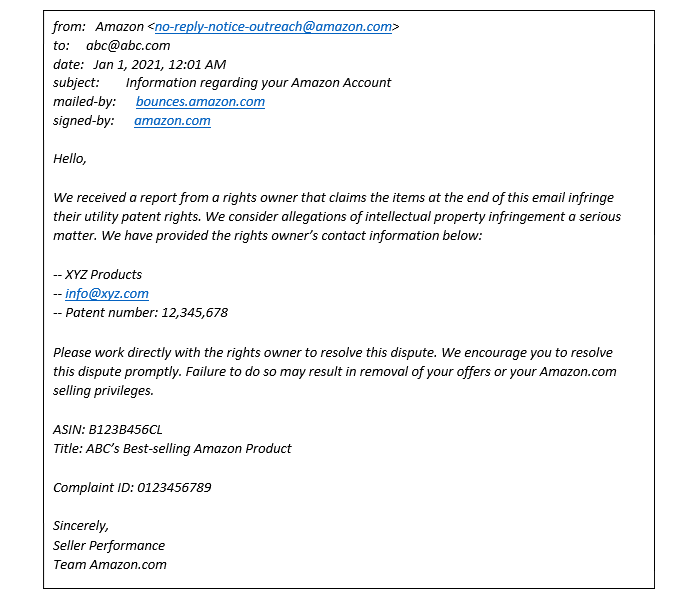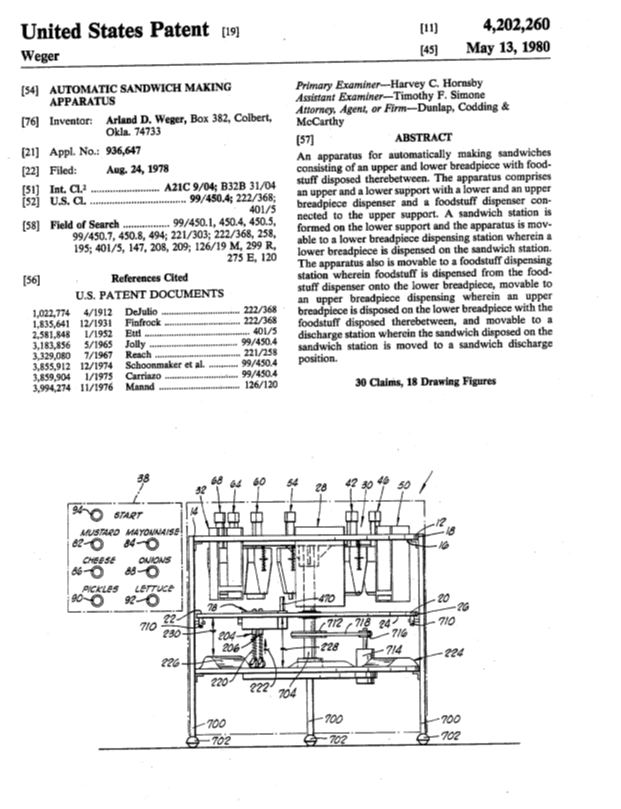Fight Against Amazon Owner’s Rights Claim
Here is a hypothetical situation that, unfortunately, may not be so hypothetical for your company:
Your Company, ABC LLC, is doing well on Amazon – you are taking orders and receiving positive attention and attracting customers. Then, in your e-mail inbox, you receive notice of some unwanted attention, and it looks something like this:
Preliminary Steps to Take Next Against a Patent Infringement
This can be a terrifying e-mail to receive, and you have no idea how to respond. Navigating the patent world is a daunting task, especially when you do not know where to start. So here are a few preliminary steps you can take if you receive a notice of patent infringement from Amazon:
#1: Get a copy of the patent.
There are many websites which allow you to find or “pull” the patent at issue. Simply go to one of the following sites and enter the patent number identified in the e-mail complaint:
http://patft.uspto.gov/netahtml/PTO/srchnum.htm
For example, if the e-mail from Amazon identified Patent No. 4,202,260, you could go to one of these sites, enter the number and receive the following in response:
This is the front page of a patent, which, in this example, is a patent related to an automatic sandwich maker. For a more thorough analysis of the parts of a patent, see the related post “Anatomy of a Patent” but for our purposes here, once you have pulled the patent, you will want to focus on the property right of a patent – the claims.
#2: Turn to the “claims” of the patent.
Patents can be unwieldy, sometimes having 50 pages or more of text. However, identifying the actual property right is a simpler proposition than you might expect. The property rights of a patent are what is referred to as the claims of the patent and are located at the very end of the patent. In the case of the sandwich maker, the claims start on page 17 of the example patent and begin with the magic words “What is claimed is” (or some slight variation):
The patent will then go on to detail the elements of the claimed invention. It is the language of these claims that is used to assess whether there is an infringement. All of the other information contained in the patent (e.g., “DESCRIPTION OF THE PREFERRED EMBODIMENT” starting on page 7) is used to support or describe what is ultimately claimed as the invention.
#3: Comparison of the “claims” of the patent to your product
The next step is the most involved step – comparing the language of the claims to your product. Every claim contains multiple “elements” or “limitations.” These are just ways to refer to the multiple sub-steps or sub-parts of each of the enumerated claims of the patent. Infringement analysis, at its core, involves comparing each claim limitation to the accused product; if the limitation is not met or present in the accused product, there is no infringement. However, that analysis can get quite complicated, and usually starts with what the words of the claims mean. In our sandwich maker example, there might be an issue with what “breadpiece” means or what is considered a “foodstuff.” There are many rules pertaining how to properly characterize and define the words of patent claims for a patent infringement analysis. For those unfamiliar with undertaking such an analysis, and even for those who have some experience in the patent process, it is always wisest to consult an attorney with patent experience to navigate these sometimes-muddy waters of patent law.
While the above steps may not give you final answers how to deal with a complaint from Amazon, it hopefully makes the process a little less terrifying.
A ESQgo Amazon patent lawyer is uniquely equipped to assist you in these types of matters. We combine e-commerce law expertise, including dealing with Amazon, with patent expertise to help you assess and resolve whatever needs you might have.




